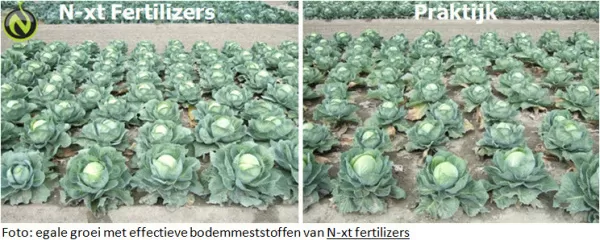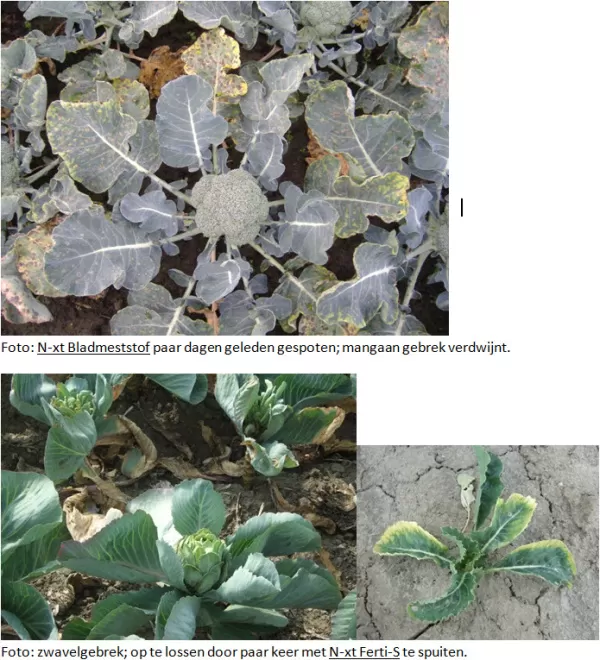
There is a strong link between soil, food quality and our health

Fertilising differently is essential to retain soil and crop quality
Many years of intensive fertilisation with the same fertiliser puts pressure on soil health, which reduces the yield and the quality of the products. Clear evidence is coming through now the fertilisation standards are tightened up and the soil needs to keep its fertility intact under its own steam, for example by soil life breaking down organic matter. “Unfortunately, the agricultural sector is still not sufficiently aware of this problem”, says Marco van Gurp, fertilising specialist of N-xt Fertilizers.
As a fertilising specialist, Marco van Gurp believes it is his task to make the agricultural sector more aware of what actually happens in the soil. In many cases that is not much to write home about. “Reduced humus content, structural deterioration, pH too low, soil life affected and a lack of balance in the soil chemistry”, lists Mr Van Gurp. Reducing the fertilisation limits shows up these shortcomings more and more. “That type of soil is incapable of producing a good crop under its own steam.”
The result is that many last-ditch attempts are made in the form of excessive use of fertilisers and crop-protection agents. The cultivation costs go up and up. Marco van Gurp argues that it would be much better if we restored the balance of the soil as this improves the yield as well as the quality of the crops. Mr van Gurp comments “Crops have a longer shelf-life and they are more resistant to many types of diseases.”
A healthy and viable cultivation means you have to take account of four focus points according to Mr van Gurp: yield, quality, crop resistance and soil quality. “If you've got those aspects in order, you will achieve the best yields in the long term. And you keep your soil healthy”, says Marco van Gurp. A brief explanation:
1. Yield
You often hear 'it's all about the yield!', but is that actually true? If we purely consider the economic model, perhaps it is - more kilos of product equals more Euros in your pocket. However, that is far too simplistic for the long term. A one-sided focus on maximum yield has brought us to this situation - a soil that needs more and more input in order to achieve the same production levels. Bizarrely enough, that input is actually the problem. In recent years, the government has restricted the excessive use of organic and mineral fertilisers more and more. More growers now realise that you do not need more, but better fertilisation.
Different input
According to the fertilisation expert you need to look at a different input and not at more of the same. Yet the industrial era taught us that more of the same was the only way to achieve an increase in yield and a reduction in cost price. We forget that when we talk about soil fertility, we are not always that aware of all the processes. The soil is complex and the unknown processes are the keys to higher and stable yields in the total process. For example, consider the physiology of the soil (structure, pH, soil particles), the biology of the soil (1 to 5 billion organisms per teaspoon) and soil chemistry (balance of the clay-humus complex).
More with less
“Soil and leaf fertilisers from N-xt Fertilizers have the unique property of not leaching out”, explains Mr van Gurp. “This means that all the applied nitrogen, phosphate and trace elements are guaranteed available and all of them are absorbed efficiently by the crop. In relation to standard fertilisers this achieves savings of 10 to 30% on nitrogen and up to 50% on phosphate. Yet the crop yield remains the same or increases slightly.“

2. Quality
Crop quality is becoming increasingly important. “Particularly for products that must be stored, such as cabbage, potatoes, onions and carrots", says Marco van Gurp. “It is good to realise that a product needs to collect all the basic building blocks for quality from the soil. Then you have to ask yourself the following questions: Does the soil have what is needed for quality? Can it be absorbed? These aspects are just as important as the starting material, the storage process and any additives. “
Outside and inside
Marco van Gurp believes that micronutrients produce many processes in the plant that contribute to a qualitatively healthier product. “This concept makes us realise that quality is not just about the outside and long-term storage of a product, but that it is also about the content of a product. More and more businesses realise that taste and nutrients play a role in the shift to a more organic production model where soil, food and public health are closely linked.”
The role of N-xt products
In cabbage cultivation an even crop is important in order to be able to harvest real quality at one specific harvest time. N-xt leaf fertilisers can play a role according to consultant Marco van Gurp. The right nitrogen correction in combination with different trace elements, such as calcium, magnesium and manganese, can improve the uniformity of a cabbage crop significantly. “We now also have an organic sulphur in our range, which can help a crop through stressful periods and growth stagnations.”

3. Crop resistance
Marco believes we have gone too far in using chemicals to deal with symptoms, even through prevention is always more effective and cheaper than the cure. We can achieve this by thinking more ecologically on the basis of a cycle. There is a major role for soil quality and the right fertiliser products as a supplement. Mr van Gurp comments “A healthy plant that develops naturally is much stronger and better able to resist attacks from pathogens. Remember that diseases can never be eradicated. In that case it is always better to make sure that the plants themselves are resistant to these negative influences.”
Nutrients instead of chemicals
“If you eat well, you're less likely to fall ill”, concludes Mr van Gurp. “Surely crops would be more resistant if we stopped pestering them with intensive tillage, salt concentrations around the roots that are too high and not enough soil life?” He explains that crops become more resistant by ensuring enough organic matter, optimum CEC ratios and the right form of fertilisers that do not have a harmful effect on soil life.
No salinating effect
In contrast to many common mineral fertilisers, the products of N-xt Fertilizers do not have a salinating effect on the soil. The products support bacteria and moulds in the soil and increase the resistance of soil life. N-xt FertiSoil is an example of such a product; it helps to breakdown the crop remnants after cultivation, but also shows that it makes a positive contribution to dealing with club root. It encourages root growth and gives the plant extra resistance to continue growing.

4. Healthy soil
The last task of 'soil and fertilising' is to retain and encourage a healthy soil, as that is the only way to achieve good results in the long term. When a farmer purchases fertilisers he will have to be more aware of the other consequences of fertilisers, apart from the increase in yield. Again, yield is and remains important but it will have to be protected for the long term too.
Natural thinking
One-sided fertilising over the last 40-50 years has brought us to this juncture, and it is time to start thinking differently. Perhaps that is simpler than many people believe. “We need to start thinking in terms of natural processes”, suggests Marco van Gurp. Ever since World War II we have known that fertilisers only increase the yield temporarily. Then the soil deteriorates, the organic matter breaks down quicker and limits the absorption of many elements.
This fact means we need to consider the use of fertilisers for a crop from a different point of view. The starting point will have to be a comprehensive soil analysis and that will have to form the basis for making more effort to return the soil to the required situation. Then it is possible to cultivate sustainably and to maintain quality and yield with a lower cost price.
Albrecht method
Mr van Gurp comments “In N-xt Fertilizers' advice an optimum soil is the focal point.” From the point of view of soil chemistry, the size and composition of the CEC (clay-humus complex) is an important starting point. The ‘Albrecht method’ is used to target a composition of roughly 68% Ca, 12% Mg, 5% K and 10% H. On this basis, the optimum pH is 6.3 and soil life develops well to make many nutrients available to the crop. “N-xt Fertilizers works together with the grower to achieve the optimum for his soil”, explains Mr van Gurp. “Different tillage is possible with different products. Then we can assess which fertiliser is needed and how effective we can expect it to be.
The above four focus points are the basis for yielding crops. You could consider yield, quality, crop resistance and soil health separately, but in the end one leads to the other. You determine the order.
For more information, please call Marco van Gurp (+31 (0)6-10554238)








